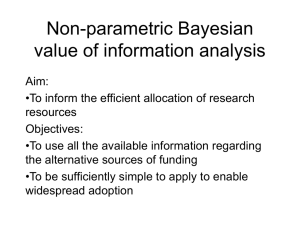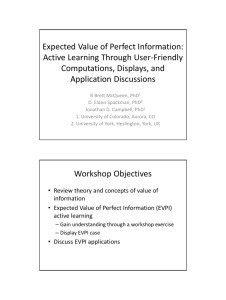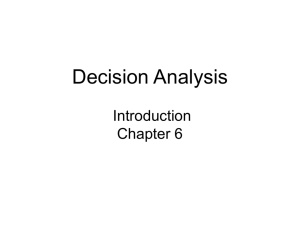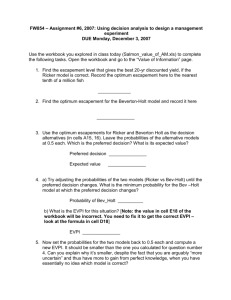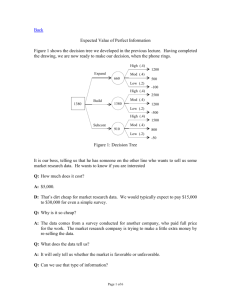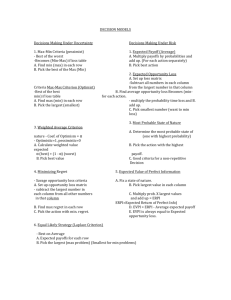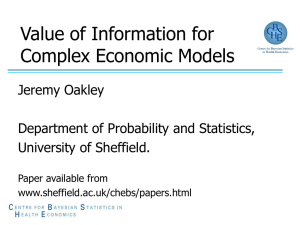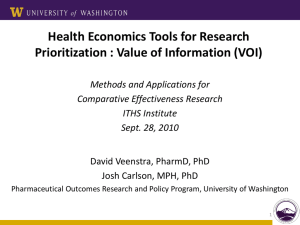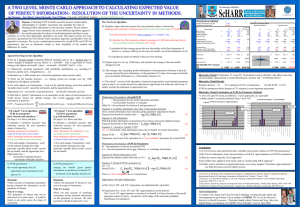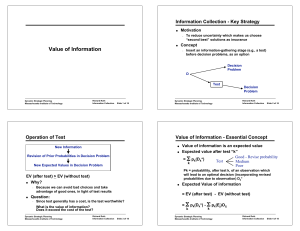Bayesian decision theory and value of
advertisement
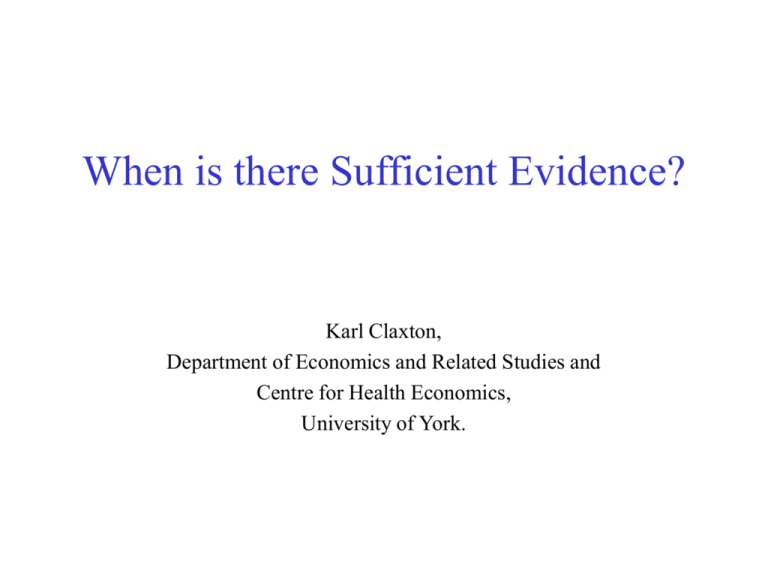
When is there Sufficient Evidence? Karl Claxton, Department of Economics and Related Studies and Centre for Health Economics, University of York. Sufficient evidence for decision making • Informing decisions • Prioritising research – Examples from the NHS HTA Pilot • • • • • Designing research Evaluating regulatory policies Implementation UK policy impact Implications and challenges The decisions • Should a technology be adopted given existing information? – Which clinical strategies are cost-effective? – For which patient groups? • Is additional evidence required? – What type of evidence – What type of studies – For which patient groups – How much evidence Informing decisions • Requirements – – – – Structuring clinical decision problems Characterisation of decision uncertainty Value of additional research Decisions consistent with objectives and constraints Structuring clinical decision problems • Requirements – – – – – Compare all alternative interventions/strategies Explore the full range of clinical policies For range of patient groups Over an appropriate time horizon Combine evidence from variety sources Characterising uncertainty • Evidence for all model parameters – Systematic searching for all parameters – Methods of synthesis • Direct evidence – Different types of study (potential bias/exchangeability) • Networks of evidence – Indirect and mixed comparisons – Evidence on functions of parameters • Probabilistic analysis of the decision model Mixed and indirect comparisons Alternative interventions • Compare all interventions • No RCT of all • Pair wise comparisons? • Use all the information – Mixed comparisons – Same assumptions as random effect meta analysis – Estimate posterior LOR with correlations A B 1 x x 2 x 3 x RCTs D x x 4 x 5 x 6 C x x x x Networks of evidence A A+B A+C A+B+C B C B+C Value of additional research Is further evidence required? • Expected value of perfect information (EVPI) – Maximum return to research (decision problem) – Necessary condition (EVPI>costs) What type of evidence? • EVPI for parameters – Maximum return to different types of research – Focusing research design An example • A pilot study of value of information analysis to inform the NHS health technology assessment programme – Screening for age-related macular degeneration – Manual chest physiotherapy techniques for asthma and chronic obstructive pulmonary disease – *long-term antibiotic treatment for preventing recurrent urinary tract infections (UTI) in children* Structuring the decision problem Frequency of recurrent UTIs Number of pyelonephritic attacks Progressive renal scaring End-stage renal disease No UTI 1 UTI Pyelonephritic attack 2 UTIs Pyelonephritic attack 3 UTIs Pyelonephritic attack 4 UTIs Pyelonephritic attack Transplant Number of attacks Progressive renal scaring Development of ESRD Age at ESRD onset Dialysis The evidence • Effectiveness – Existing reviews (variable quality) – Meta analysis, Multiple parameter synthesis • Natural history – Epidemiological studies – Pooled trial baselines – Registry studies • Quality of life – Published studies – Survey • Costs – Published studies – Published unit costs and dosage (BNF, PSSRU, CIPFA) Characterising decision uncertainty 1 Intermittent 0.9 Cotrimoxazole Nitrofurantoin 0.8 Trimethoprim Probability cost-effective 0.7 Frontier 0.6 0.5 0.4 0.3 0.2 0.1 0 £0 £10,000 £20,000 £30,000 £40,000 Threshold for cost-effectiveness £50,000 £60,000 The irrelevance of inference? • The choice between alternative technologies should be based on expectation. Inference is irrelevant to treatment choice • The only valid reason to characterise the uncertainty surrounding outcomes of interest is to establish the value of additional information • Distinguish the separate steps of deciding which technology should be chosen, given existing information, from the question of whether more evidence is required to support this decision Is further evidence required? • Expected cost of uncertainty – Adoption based on existing information is uncertain – There is a probability of making the wrong decision – There are costs of making the wrong decision • Expected value of perfect information (EVPI) – Maximum return to research (decision problem) – Necessary condition (EVPI>costs) EVPI for the decision problem Treatment A Treatment B Treatment C Optimal treatment Iteration 1 11 12 13 C 13 Iteration 2 12 10 9 A 12 Iteration 3 13 18 15 B 18 Iteration 4 14 16 17 C Iteration 5 15 14 11 A Expected NB 13 14 13 Current information = 14 Perfect information = 15 EVPI = 15- 14 = 1 EVPI = Eθ maxj NB(j, θ) - maxj Eθ NB(j, θ) Max NB 17 15 15 Is further evidence required? Population EVPI £4,000,000 £3,500,000 Populaion EVPI £3,000,000 £2,500,000 £2,000,000 £1,500,000 £1,000,000 £500,000 £0 £0 £10,000 £20,000 £30,000 £40,000 Cost-effectiveness threshold £50,000 £60,000 EVPI for parameters EVPPIφ = Eφ maxj Eψ |φ NB(j, φ,ψ) – maxj Eθ NB(j,θ) Where: φ = parameter of interest ψ = other uncertainties Some implications: • Information about an input is only valuable if it changes our decision • Information is only valuable if the parameter does not resolve at its expected value General solution (linear and non linear models) m od el D ev ES el op R D m e nt C on of se ES q Ef ue R fe D nc ct e s of of Lo ES ng R -te D rm Ef an fe ti b ct io of ti c s co tri Ef m fe ox ct az of ol ni e tro fu Ef ra fe na ct to of in tri m et ho Ef pr fe im ct < 6 m on Ef th fe s ct > 6 m on th s of U of TI py el on ep hr i ti s U ti l R i ty is k of of U PR TI S /p ye lo ne ph ri t is eq ue nc y Fr eq ue nc y Fr Fu ll Expected Value of Perfect Information What type of evidence? £2,500,000 £2,000,000 £1,500,000 £1,000,000 £500,000 £0 Prioritising research • Other methods – Unrelated to the returns from research – Research as a means changing clinical practice • Statistical decision theory – Reduction in the costs of decision uncertainty – Value consistent with objective and constraints of service provision – Allocation within and between clinical areas – Allocation between research and service provision Design of future research • EVPI exceeds cost of research? – Necessary but not sufficient • Benefit of sample information – Predict possible future samples and posteriors – Expected net benefits with and with out sample information – Expected value of sample information (EVSI) • Societal payoff from proposed research – EVSI - cost of sampling – Expected net benefit of sampling (ENBS) EVSI: predicting the results of proposed research N=1 NBj NBj NBk N=20 NBj pdf pdf Prior Distribution Predicted Posterior Distributions Prior Distribution Predicted Posterior Distr ibutions 0.0 0.2 0.4 NBj Probability 0.6 0.8 1.0 0.0 0.2 0.4 NBj Probability 0.6 0.8 1.0 Expected net benefit of sample information (all parameters) £3,500,000 EVSI Cost(n) ENBS £3,000,000 EVSI, cost(n), ENBS £2,500,000 £2,000,000 £1,500,000 £1,000,000 £500,000 £0 0 100 200 300 400 500 600 700 800 Sample size (n) 900 1000 1100 1200 1300 1400 1500 ENBS and n* for a portfolio of research designs £1,800,000 PIP RSD,PHZ UPA Expected net benefit of sample information £1,600,000 £1,400,000 £1,200,000 £1,000,000 £800,000 £600,000 £400,000 £200,000 £0 0 100 200 300 400 500 600 700 800 Sample size (n) 900 1000 1100 1200 1300 1400 1500 Efficient research designs • • • • • • • • • Sufficient condition (ENBS>0) Optimal sample size Allocation of patients to the arms of a trial Optimal stopping of sequential trial Which endpoints should be included? Optimal follow-up What are relevant alternatives Optimal portfolios of research Optimal development programmes Regulation of health technologies “...A reasonable basis for a claim [of cost-effectiveness] depends on a number of factors relevant to the benefits and costs of substantiating a particular claim. These factors include: the type of product, the consequences of a false claim, the benefits of a truthful claim, the costs of developing substantiation for the claim ...” (FDA, section 114, modernization act of 1997) Regulation of health technologies • Is it efficient to conduct further research? – Define a claim/submission as “substantiated” and evidence as “competent and reliable” when it is not efficient to conduct further research • Should demand: – More evidence for some technologies as compared to others – Different types of evidence for different technologies – Different amounts of evidence for the same technology in different circumstances • Role of the regulator? – Policing the priors Evaluating regulatory policies • Societal value of information – Socially optimal development decisions – Socially optimal amount/type of evidence • Commercial value of information – – – – Commercial payoff function Payoff conditional on licensing and reimbursement Commercially optimal development decisions Commercially optimal amount/type of evidence • Optimal policies – Were commercial development and information decisions match societal needs Implementation • Value of information and the value of implementation Information Implementation Current “Perfect” Current A B “Perfect” C D • Realising the value of information - EVPI = D-C - “Realisable” EVPI = B-A • Value of changing clinical practice - Current information = C-A - With additional information = D-B • Evaluate policies to change clinical practice - Can invest in information, implementation or both = D-A UK Policy impact • National Institute for Clinical Excellence – Pilot study to inform research recommendations – Guidance on methods of technology appraisal – Decision analytic modelling required – Evidence synthesis and probabilistic analysis required – Value of information analysis recommended • NHS Health Technology Assessment Programme – Pilot study of setting research priorities • Medical Research Council – Programme on value of information – Programme on evidence synthesis for decision making – Cancer Trials Unit Programme Implications and challenges • Rational decision making - Adoption decisions - Research decisions - Additional objectives, constraints and irreversibility • Characterising uncertainty - Indirect comparisons and networks of evidence - Bias and exchangeability - Model structure • Computation - Correlation and complex data structures - Non multi-linear and complex models - Dimensions of design space
